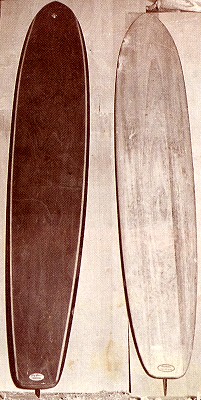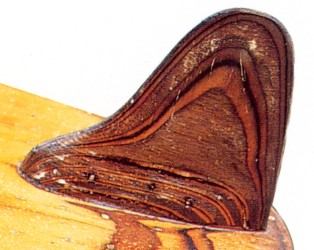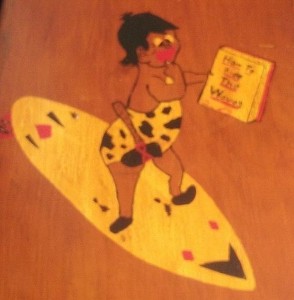 |
surfresearch.com.au
history : the
okinuee |
| home | catalogue | history | references | appendix |
|
| The impact of the Malibu
design was magnified by the footage shot for Ampol being
shown in cinemas and subsequently in Surf Clubs. With huge demand for the new boards and no established supply of balsa wood, compounded by a lack of technical experience with fibreglass, the Malibu design is constructed with the current hollow board technology. The Racing Sixteen builders, principally Gordon Woods, Bill Wallace, Norm Casey and Barry Bennett in Sydney and Frank Adler in Brisbane, adapted Tom Blake's Hollow Board design of plywood sheets over a strutted timber frame to Malibu dimensions, the result known as the Okinuee. The enthusiasm for the new
design was such that Gordon Woods had built and tested
his first Okinuee before the US team departed. Image right : Gordon
Woods' Velzy-Jacobs fibreglassed balsawood Malibu
surfboard, purchased from Bob Burnside (right) and
his first plywood copy. |
 |
Curved profile rail shape was a
feature on the Solid wood boards of the 1930's, but the Racing
16 used an easily constructed square rail.
The Okinuee required the outside
rails to be cut of oversized timber and then fixed to the
central struts. Crossbeams and solid nose and tail sections
completed the frame.
Plywood panels were then fixed,
mostly with screws and glue, and a draining plug added.
The solid rail sections were then
shaped, much in the manner of the laminated solid wood boards
manufactured in Hawaii and mainland USA in the later 1930's.
The addition of the fin was a major
structural difficutly, since it was invarriably added after the
board was constructed.
Most common seems to be mitred into
the central strut and held mainly by glue and nails.
Some designers were more structurally
adventerous and incorporated side supports, a precedent for the
use of fibreglass rovings to add side strength to the
finbase in the 1960's.
 |
Left: Wood fin, circa 1957 8'' x 9'' base x 0'' span @ 1 inches (Approximation) Okinuee - Hollow malibu board adaptation. Note base support and nails. Brisbane Australia, Darryl Homan collection
|
 |
Hand-painted
Okinuee Nose Decor, 1957. Book title reads How to Ride the Waves. Twin D-Rounded keel Fins
Plywood timber, 3 1/2" x 8" base, fixed by dowel through deck and redwood side supports and brass screws |
Boat Plans Pty. Ltd. produced a set
of construction plans and instructions for the "Okanoie" in
1957.
See: Allan Levick, Bondi 1957
In 1957 Vern Cooper filmed his friend Allan Levick
surfing at Bondi on his ‘hollow mal’, built by Gordon Woods.
This is extremely rare footage, possibly unique,
featuring the Australian hollow mal, which was a plywood
adaption of the American ‘malibu’ style board that first
appeared in Sydney in 1956.
Big thanks to Allan Levick for providing the footage and
Dennis Greaves for the digital transfer.
Kind thanks to Vern Cooper for making his amazing footage
available.
https://blogs.sydneylivingmuseums.com.au/surfcity/?p=2673
| This was not to be the case
in New Zealand were the design specifications were
quickly absorbed but the development of a locally
produced fibreglass board was still some years away.
The Levine was a brand name for New Zealand hollow timber board marketed as a do-it-yourself pre-cut kit, circa1958. Based on the Malibu board (see Okinuee, Australia) it featured a wide square tail, narrow rounded nose and a standard D fin set right at the pod. Most interesting is the full vee bottom from nose to tail. Common factory length appears to be 9 ft 1 inch. Thanks to Tony Reid, New Zealand. The Okinuee also had a
further overseas influence. |
 |

| home | catalogue | history | references | appendix |
1961 Harris, Reg. S.The
History of Manly Life Saving Club 1911-1961
Published by Manly Life Saving Club,
NSW Printed by Publicity Press Ltd.
1966 Finney, Ben and
Houston, James D. : Surfing – A History of the Ancient
Hawaiian Sport
Pomegranate Books P.O. Box 6099
Rohnert Park, CA 94927 Reprint 1996
1968 Kahanamoku, Duke With
Brennan, Joe: Duke Kahanamoku’s World of Surfing
Angus and Robertson Publishers Sydney
, Australia 1972 2nd Edition A&R Paperbacks, Sydney ,
Australia
1970 Margan, Frank and
Finney, Ben R. : A Pictorial History of Surfing
Paul Hamlyn Pty Ltd, 176 South Creek
Road, Dee Why West, NSW 2099.
1964 Pollard, Jack
(ed.): The Australian Surfrider
K.G.Murray Publishing Co.P/L,142
Clarence Street , Sydney Australia
1972 The Best of
Tracks (Vol. I) Editors : Falzon, Albert;
Stewart, John; Grissim, John. :
Tracks Publishing Co Pty Ltd. P.O.
Box 178 Avalon, NSW.
'Bob McTavish’s Personal History of
Surfboard Design – Pods for Primates Parts 1' (pages 120 – 122).
1992 Stell, Marion K.
: Pam Burridge
Collins Angus & Robertson
Publishers (Australia) Pty. Limited
A division of Harper Collins
Publishers (Australia) Pty. Limited
25 Ryde Road, Pymble NSW 2073,
Australia
1997 Warshaw, Matt : Surfriders
–
In Search of the Perfect Wave
Tehabi Books, Inc. Collins
Publishers, 10 East 53rd Street, New York, NY 10022
1978 Warwick, Wayne A
Guide to Surfriding in New Zealand Second Edition
Viking Sevenseas Ltd Wellington, New
Zealand
1979 Young, Nat ;
Photographs by McCausland, Bill: Nat Young’s Book of Surfing
A.H. & A.W. Reed Pty. Ltd. 53
Myroora Rd, Terry Hills, Sydney.
1983 Young, Nat with
McGregor, Craig : The History 0f Surfing
Palm Beach Press,40 Palm Beach Road,
Palm Beach NSW 2108
1972 Surfing World. Volume 16 #4. Bob Evans : 'remember the time when...' pages 30 to 35.

| home | catalogue | history | references | appendix |